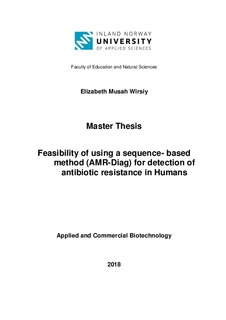Feasibility of using a sequence- based method (AMR-Diag) for detection of antibiotic resistance in Humans
Master thesis

Åpne
Permanent lenke
http://hdl.handle.net/11250/2595498Utgivelsesdato
2018Metadata
Vis full innførselSammendrag
Antibiotic resistance has become a global problem and the need to hinder its continuous spread due to inappropriate prescribing of antibiotics, overuse of antibiotics in livestock, and insufficient hygiene practices in hospital, global trade and travel is of utmost concern. Treating resistant infections have an effect on both the hospital and society. The absence of accurate diagnosis of clinical infections is a call for rapid evidence-based diagnostic tests to help clinicians better identify and target bacteria causing infections. The proposed tool, AMR-Diag seeks to fulfil the need in the reduction of AMR spread with faster and more accurate diagnostics.
In order to validate the need and establish early feasibility for the development of ABR-Diag, we used primary data from exploratory discussions from both representatives from microbiology lab and team with proposed tool, secondary data from articles amd databases. We used the Business model canvas to create value for the company and the Value Proposition Canvas to create value for customers.
Norway adopts the EUCAST guidelines whose diagnostic workflow takes up to 3-4 days before a patient can get appropriate treatment with antibiotics. However, the sequence-based diagnostic workflow on ABR differs from the current standard EUCAST disk testing. AMR-Diag has a competitive advantage over other diagnostic methods. Length of patient stay in hospital is a serious cost element.
The cost of DNA sequencing is a major obstacle for the proposed tool, AMR-Diag, to become implemented. However, the cost of DNA sequencing is expected to continue to reduce. The proposed tool AMR-Diag is a leap forward in the fight against AMR and therefore should be given a chance to prove what it can do in this course. We therefore propose that the company uses Norway as its beachhead market, and joins forces with its partners and do political lobbying for Norway to take a leading role in combating AMR.